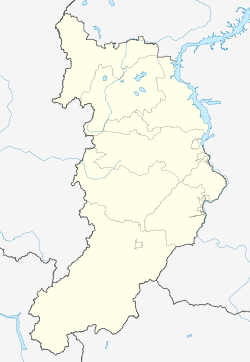Abakan (city)
| city
Abakan
Абакан
|
||||||||||||||||||||||||||||||||||||||||||
|
||||||||||||||||||||||||||||||||||||||||||
|
||||||||||||||||||||||||||||||||||||||||||
| List of cities in Russia | ||||||||||||||||||||||||||||||||||||||||||
Abakan ( Russian Абакан , of Circassian for "bear blood," according to other theories "Bear River" or "River of the fathers' [ie the Khakassians ]) is a city in southern Siberia ( Russia ) with 165,214 inhabitants (14 October 2010). It is the capital of the Republic of Khakassia and is located on the Krasnoyarsk Reservoir , on the left bank at the mouth of the Abakan River of the same name in the Yenisei .
geography
Abakan is located in the foothills of the Western Sayan at an altitude of 250 m on the banks of the river of the same name , where it flows into the Krasnoyarsk reservoir on the Yenisei.
It is about 80 km from Shushenskoye , the former place of exile of Lenin . The closest town is Chernogorsk 14 km northwest of Abakan. The distance to Moscow is almost 3400 km as the crow flies .
history
The region around Abakan has been settled for several thousand years, including archaeological finds from the Copper Stone Age Afanassjewo culture (from approx. 3500 BC) with rock carvings from the Minussinsk Basin (also known as the Khakassian-Minussinsk Basin ) and the neighboring Republic of Tuva to the south witness. It followed around 2000 BC. The regional Bronze Age Okunew culture . Three ornate stelae of this culture up close, which are exhibited in Abakan today, can be seen in the upper part of the city's coat of arms. This is followed by finds from the early Scythian Iron Age Tagar culture (from the 9th century BC) and the Tes stage , for example the Scythian burial mound Arshan -2 discovered in 2001 . The Salbyk Kurgan from the Tagar culture, about 80 km from Abakan, is 2400 years old and was originally 30 m high; the stone slabs were brought in from a quarry a dozen kilometers away. With the Tashtyk culture (from 1st century AD) the Turkic languages may have been established in the region, after their end in the 8th century AD, texts in Old Turkish Yenisei runes were written in the area, which are close to the southeastern Orkhon runes . The regional ethnic group of the Khakass was formed from the Turkish-speaking population .
The city goes back to an Ostrog , which was built in 1675 not far from the mouth of the Abakan by the Russians advancing into Siberia , which was called Abakanski ostrog or Abakansk for short ( ABаканск ). A few years later this fortification was initially abandoned due to the conflict with the Khakass and was rebuilt in 1707 under the same name about 70 km downstream (later the village of Abakanskoje, not far from today's Krasnoturansk ). Instead of the original ostrog, the village of Ust-Abakanskoje ( Усть-Абаканское , not to be confused with the early 20th century village a few kilometers north, which has been called Ust-Abakan since 1933 ) was built in the 1780s . Between the village and the train station a few kilometers south (the end of a line from Achinsk , which originally went into operation in 1916 and finally in 1923 after being destroyed in the Russian Civil War ), a new settlement was built in the 1920s, and the entire village was in 1925 in Chakassk ( Хакасск ) renamed. In 1931 the place received city rights and its current name Abakan. Despite the roughly 100-year break in settlement after 1675, this year is considered the year the city was founded.
From 1943 to 1953, various Gulag penal camps were set up in the area . They mainly served the mining of coal and gold, the construction of a petroleum-processing combine and the extraction of wood.
Former pioneer palace
Population development
| year | Residents |
|---|---|
| 1939 | 36,652 |
| 1959 | 56,416 |
| 1970 | 90.136 |
| 1979 | 128.311 |
| 1989 | 154.092 |
| 2002 | 165.197 |
| 2010 | 165.214 |
Note: census data
Economy and Transport
Thanks to nearby iron ore - and coal reserves there in Abakan iron and steel industry , and also mechanical engineering , wood processing and food industry . Together with Chernogorsk and Minussinsk , Abakan forms an industrial agglomeration with severe environmental pollution, such as air pollution. The city also has an inland port .
As an important stop on the South Siberian Railway (built in the 1960s), Abakan is connected to the Krasnoyarsk Railway network .
With the nearby Abakan Airport , Abakan also has an international airport.
Further educational institutions
- Khakass State University named after NF Katanov
- Khakas business institute
- Khakass Technological Institute of Krasnoyarsk State Technical University
Sports
The town's sporting flagship is the bandy club HK Sajany-Chakassija Abakan, founded in 1980 .
sons and daughters of the town
- Viktor Oserow (* 1958), politician
- Olga Vorobjowa (* 1990), table tennis player
- Natalja Malysheva (* 1994), wrestler
Web links
- Abakan's website (Russian)
- Abakan in the online lexicon mojgorod.ru (Russian)
- City airport
- Economic history of the city
- City bus routes and their development
- Location of the GULAG in southern Siberia
Individual evidence
- ↑ a b Itogi Vserossijskoj perepisi naselenija 2010 goda. Tom 1. Čislennostʹ i razmeščenie naselenija (Results of the All-Russian Census 2010. Volume 1. Number and distribution of the population). Tables 5 , pp. 12-209; 11 , pp. 312–979 (download from the website of the Federal Service for State Statistics of the Russian Federation)
- ↑ Abakan 1 , in: Brockhaus Enzyklopädie , 21st edition, Vol. 1, 2005, p. 20.








